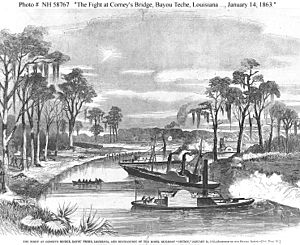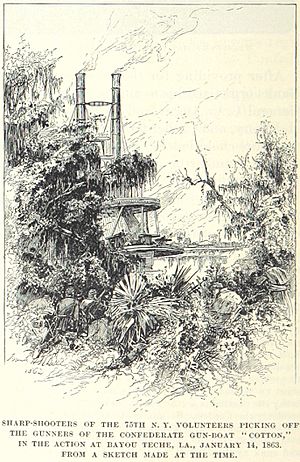CSS J. A. Cotton facts for kids

J. A. Cotton battles Union ships on January 14, 1863.
|
|
Quick facts for kids History |
|
|---|---|
| Name | |
| Owner | Confederate States Navy |
| Launched | 1861 |
| Completed | 1861 |
| Acquired | 1861 |
| Maiden voyage | 1861 |
| In service | 1862 |
| Out of service | January 15, 1863 |
| Fate | Burned and sunk to avoid capture |
| General characteristics | |
| Type | Paddle steamer/ironclad/gunboat |
| Tonnage | 549 GRT |
| Propulsion | Steam |
| Notes | Captain E. W. Fuller |

The CSS J. A. Cotton was a special kind of steamboat used by the Confederate side during the American Civil War. It was a sidewheel paddle steamer, meaning it had large wheels on its sides to move through the water. This ship was also partly an ironclad gunboat. This means it had some armor to protect it during battles.
On January 15, 1863, the crew of the J. A. Cotton burned and sank their own ship. This happened in Bayou Teche near Brashear City, Louisiana, in the United States. They did this to stop the ship from being captured by Union forces. The ship had been badly damaged in a fight against United States Navy gunboats.
Contents
Building the J. A. Cotton
The J. A. Cotton was built in Jeffersonville, Indiana, in the United States in 1861. It was launched and finished in the same year. By 1862, the Confederate navy started using it.
The ship weighed about 549 tons. It was armed with two main cannons:
- One 32-pounder smoothbore cannon. This type of cannon had a smooth barrel.
- One 9-pounder rifle cannon. This cannon had grooves inside its barrel to make the shot spin, which made it more accurate.
The J. A. Cotton was also made stronger with a special kind of armor. This armor was a cotton and timber casemate. A casemate is a protected room on a warship. It also had some railroad iron fitted to its sides. This extra protection meant it could be called an ironclad.
J. A. Cotton's Role in the Civil War
The J. A. Cotton served as a gunboat for the Confederate side during the American Civil War. It mostly operated in the waters around Berwick Bay and Bayou Teche in Louisiana.
First Battle in Bayou Teche
The ship saw its first battle on November 3, 1862, in Bayou Teche. The J. A. Cotton faced four Union gunboats:
- USS Kinsman
- USS Calhoun
- USS Estrella
- USS Diana
The battle happened near Cornay's Bridge. The J. A. Cotton held its position against 27 cannons from the Union ships for an hour and a half. It was hit a few times but did not suffer major damage. In contrast, all the Union gunboats were hit and slightly damaged. The USS Kinsman was hit over 50 times, and two of its crew members died, with four more wounded.
Over the next two days, the Union gunboats fought the J. A. Cotton two more times. These battles had similar results, with both sides having only light damage and few injuries.
Final Battle and Loss
The J. A. Cotton's next big fight happened on January 14, 1863. It was ordered to attack Union General Godfrey Weitzel's forces at Berwick Bay, Louisiana. However, General Weitzel found out about the plan. He sent out the same four Union gunboats that had fought the J. A. Cotton in November 1862.
The Union gunboats sailed into Bayou Teche with Union transport ships. Their goal was to attack the J. A. Cotton and Confederate shore batteries. These batteries were cannons placed on land below Franklin, Louisiana. When the two sides met, the Union gunboats fought the J. A. Cotton again. At the same time, Union soldiers on land fought Confederate soldiers hiding in rifle pits.
The battle continued into the next day. By the night of January 15, 1863, the J. A. Cotton was badly damaged. The crew realized they could not save the ship. They decided to set it on fire. This would prevent the enemy from capturing it. They also hoped the burning ship would sink and block the waterway. The ship was lost near Brashear City, Louisiana, United States.
The Wreck of the J. A. Cotton
The remains of the J. A. Cotton have not yet been found.

